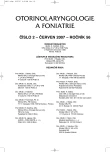Systemic Absorption of Adrenalin after Topical Administration on Nasal Mucosa
Authors:
Petr Matoušek 1; Pavel Komínek 1; J. Chalupa 2; A. Garčic 3
Authors‘ workplace:
ORL klinika FNP, Ostrava
; přednosta MUDr. P. Komínek, Ph. D.
ARO oddělení Nemocnice ve Frýdku-Místku
1; primář MUDr. J. Chalupa
Biochemická laboratoř, Poliklinika Místek
2; primář RNDr. A. Garčic
3
Published in:
Otorinolaryngol Foniatr, 56, 2007, No. 2, pp. 67-72.
Category:
Original Article
Overview
Objective:
the contribution investigated the levels of systemically absorbed adrenalin after its topical administration in nasal surgery
Type ofstudy:
prospective study
Setting:
ORL Clinic, Faculty Hospital and Policlinic Ostrava, ORL Ward, Hospital in Frýdek-Místek
Material and Methods:
a prospective evaluation of a group of patients, who were administered adrenalin topically on nasal mucosa during surgery in general anesthesia. After introduction of general anesthesia, venous blood was sampled for the determination of basal adrenalin level. Subsequently adrenalin was administered topically (on swabs) in the dilution of 1 : 10,000. In the 3rd, 5th, 7th, 10th, 13th and 15th minute after the administration venous blood was sampled for the determination of adrenalin. These levels were compared with the adrenalin level before the administration. Clinical response to the administered adrenalin was observed (blood pressure, heart rate).
Results:
seven patients (4 men, 3 women) at the average age of 29 years (the oldest being 37 and the youngest 20) were examined. The topical administration of adrenalin resulted in statistically significant elevation of adrenalin levels in the 5th, 10th and 13th minute (maximum was 121 ng/l in the 5th minute) with subsequent decrease to basal values in 15th minute. No statistically significant changes in blood pressure were recorded. A statistically significant decrease of heart rate was observed.
Conclusion:
the topical administration of adrenalin on nasal mucosa in 1 : 10,000 dilution resulted in a systemic absorption. The amount of adrenalin, which was absorbed, was relatively low, the adrenalin levels in blood reached two-fold higher levels than the basal concentration. No changes were observed in blood pressure, but there was a decrease in heart rate, probably related to the effects of anesthetics used for general anesthesia.
Key words:
adrenalin, topic administration, systemic absorption.
Sources
1. Anderhuber, W., Walch, C., Nemeth, E. et al.: Plasma adrenaline concentrations during functional endoscopic sinus surgery. Laryngoscope, 109, 1999, s. 204-207.
2. Andersson, K. E., Bende, M.: Adrenoreceptors in the control of human nasal mucosal blood flow. Ann. Otol. Rhinol. Laryngol., 93, 1984, s. 179-182.
3. Bořík, O.: Resorpční schopnost sliznice dýchacích cest. Plzeňský lékařský sborník, supplementum, 14, 1964, s. 5-72.
4. Bromley, L., Hayward, A.: Cocaine absorption from the nasal mucosa. Anaesthesia, 43, 1988, s. 356-358.
5. Demirtas, Y., Ayhan, S., Tulmac, M. et al.: Hemodynamic effects of perioperative stressor events during rhinoplasty. Plast. Reconstr. Surg., 115, 2005, s. 620-626.
6. Dunlevy, T. M., O’Malley, T. P., Postma, G. N.: Optimal concentration of epinephrin for vasoconstriction in neck surgery. Laryngoscope, 106, 1996, s. 1412-1414.
7. Ganong, W. F.: Přehled lékařské fyziologie. Jinočany: H & H, 1995, s. 681, ISBN 80-85787-39-9.
8. Chelliah, Y. R., Manninen, P. H.: Hazards of epinephrine in transsphenoidal pituitary surgery, J. Neurosurg. Anaest., 14, 2002, s. 43-46.
9. Jeck-Thole, S., Hallbaum, I., Pichlmayr, I.: Anesteziologie - praktická příručka. 1. vydání, Martin: Osveta, 1998, s. 312, ISBN 80-888-2482-6.
10. John, G., Low, J. M., Tan, P. E. et al.: Plasma catecholamine levels during functional endoscopic sinus surgery. Clin. Otolaryngol., 20, 1995, s. 213-215.
11. Katzung, B. G.: Základní a klinická farmakologie. Jinočany: H&H, 1995, s. 1072, ISBN 80-85787-35-0.
12. Kasemsuwan, L., Griffiths, M. V.: Lignocaine with adrenaline: is it as effective as cocaine in rhinological practice? Clin. Otolaryngol., 21, 1996, 127-129.
13. Komínek, P., Matoušek, P., Chalupa, J.: Poznámky k rizikům použití adrenalinu u endonazálních operací. Otorinolaryng. a Foniat. /Prague/, 52, 2003, s. 83-89.
14. Larsen, R. a kol.: Anestezie. 2. vydání, Praha, Grada, 2004, s. 1376, ISBN 80-247-0476-5.
15. Lawes, E. G.: Complications of endoscopic sinus surgery. J. Royal. Soc. Med., 90, 1997, s. 586.
16. Lormans, P., Gaumann, D., Schwieger, I. et al.: Ventricular fibrillation following local application of cocaine and epinephrine for nasal surgery. ORL J. Otorhinolaryngol. Relat. Spec., 54, 1992, s. 160-162.
17. Maaranen, T. H., Mantyjarvi, M. I.: Central retinal artery occlusion after a local anesthetic with adrenaline on nasal mucosa. J. Neuroophtalmol., 20, 2000, s. 234-235.
18. McClymont, L. G., Crowther, J. A.: Local anaesthesia with vasoconstrictor combinations in septal surgery. J. Laryngol. Otol., 102, 1988, s. 793-795.
19. Millay, D. J., Wayne, F. L., Carpenter, R. L.: Vasoconstrictors in facial plastic surgery. Neck Surg., 117, 1991, s. 160-163.
20. Navarro, R. et al.: Humans anesthetized with sevoflurane of isoflurane have similar arrhythmic response to epinephrine. Anesthesiology, 80, 1994, s. 545-549.
21. Savino, P. J., Burde, R., M., Mills, R. P. et al.: Visual loss following intranasal anesthetic injection. J. Clin. Neuroophtalmol., 10, 1990, s. 140-144.
22. Schenck, N. L.: Local anesthesia in otolaryngology. A re-evaluation. Ann. Otol., 84, 1975, s. 65-72.
23. Stammberger, H.: Functional endoscopic sinus surgery. Philadelphia, B. C. Decker, 1991, s. 529, ISBN 09-411589-6-9.
24. Van Hasselt, C. A., Low, J. M., Waldron, J. et al.: Plasma catecholamine levels following topical application versus infiltration of adrenaline for nasal surgery. Anaesth. Intensive Care, 20, 1992, s. 332-336.
25. Wanamaker, H. H., Arandia, H. Y., Wanamaker, H. H.: Epinephrine hypersensitivity-induced cardivascular crisis in otologic surgery. Arch. Otolaryngol. Head Neck Surg., 111, 1994, s. 841-844.
Labels
Audiology Paediatric ENT ENT (Otorhinolaryngology)Article was published in
Otorhinolaryngology and Phoniatrics

2007 Issue 2
Most read in this issue
- Oroantral and Oronasal Communication Closure Possibilities Summary
- The Arnold‘s Reflex
- Head and Neck Liposarcomas
- Systemic Absorption of Adrenalin after Topical Administration on Nasal Mucosa
